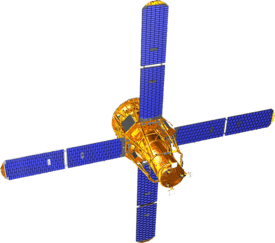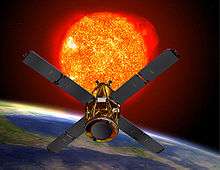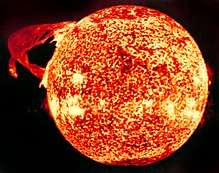Reuven Ramaty High Energy Solar Spectroscopic Imager
Reuven Ramaty High Energy Solar Spectroscopic Imager (RHESSI, originally High Energy Solar Spectroscopic Imager or HESSI) was a NASA solar flare observatory. It was the sixth mission in the Small Explorer program, selected in October 1997[1][6] and launched on 5 February 2002. Its primary mission was to explore the physics of particle acceleration and energy release in solar flares.
 Illustration of RHESSI | |
| Names | Explorer-81, SMEX-6 |
|---|---|
| Mission type | Solar observatory |
| Operator | NASA / Goddard Space Sciences Laboratory |
| COSPAR ID | 2002-004A |
| SATCAT no. | 27370 |
| Website | https://hesperia.gsfc.nasa.gov/rhessi3/ |
| Mission duration | Planned: 2 years[1] Final: 16 years, 6 months, 10 days |
| Spacecraft properties | |
| Manufacturer | Spectrum Astro[1] |
| Launch mass | 293 kg (646 lb)[2] |
| Dimensions | 2.16 × 5.76 m (7.1 × 18.9 ft)[2] |
| Power | 414 W[2] |
| Start of mission | |
| Launch date | 5 February 2002, 20:58 UTC[3] |
| Rocket | Pegasus XL |
| Launch site | Stargazer, Cape Canaveral |
| Contractor | Orbital Sciences |
| End of mission | |
| Disposal | Decommissioned |
| Deactivated | 16 August 2018[4] |
| Decay date | c. 2022[4] |
| Orbital parameters | |
| Reference system | Geocentric |
| Regime | Low Earth |
| Semi-major axis | 6,875.9 km (4,272.5 mi) |
| Eccentricity | 0.0011 |
| Perigee altitude | 490.3 km (304.7 mi) |
| Apogee altitude | 505.3 km (314.0 mi) |
| Inclination | 38.0367° |
| Period | 94.5667 min |
| RAAN | 59.1113° |
| Argument of perigee | 152.3223° |
| Mean anomaly | 207.8129° |
| Mean motion | 15.2265 rev/day |
| Epoch | 2 September 2015, 12:16:06 UTC[5] |
| Revolution no. | 74636 |
| Main telescope | |
| Type | Coded aperture mask |
| Focal length | 1.55 m (5.1 ft) |
| Collecting area | 150 cm2 (0.16 sq ft) |
| Wavelengths | X-ray / γ-ray |
| Resolution | 2 arcsec up to 100 keV 7 arcsec up to 400 keV 36 arcsec above 1 MeV[2] |
Small Explorer program | |
HESSI was renamed to RHESSI on 29 March 2002 in honor of Reuven Ramaty, a pioneer in the area of high energy solar physics. RHESSI was the first space mission named after a NASA scientist.[7] RHESSI was built by Spectrum Astro for Goddard Space Flight Center and was operated by the Space Sciences Laboratory in Berkeley, California. The principal investigator from 2002 to 2012 was Robert Lin, who was succeeded by Säm Krucker.[8]
Following communication difficulties, RHESSI ceased science operations on 11 April 2018 at 01:50 UTC.[9] RHESSI was decommissioned on 16 August 2018, and remains in a stable low-Earth orbit. However, since it has no means of propulsion, atmospheric drag will eventually pull the spacecraft into Earth's atmosphere, which may occur as early as 2022.[4]
Mission concept
RHESSI was designed to image solar flares in energetic photons from soft X-rays (~3 keV) to gamma rays (up to ~20 MeV) and to provide high resolution spectroscopy up to gamma-ray energies of ~20 MeV. Furthermore, it had the capability to perform spatially resolved spectroscopy with high spectral resolution.
Scientific objectives
Researchers believe that much of the energy released during a flare is used to accelerate, to very high energies, electrons (emitting primarily X-rays) and protons and other ions (emitting primarily gamma rays). The new approach of the RHESSI mission was to combine, for the first time, high-resolution imaging in hard X-rays and gamma rays with high-resolution spectroscopy, so that a detailed energy spectrum can be obtained at each point of the image.
This new approach enabled researchers to find out where these particles are accelerated and to what energies. Such information will advance understanding of the fundamental high-energy processes at the core of the solar flare problem.
The primary scientific objective of RHESSI was to understand the following processes that take place in the magnetized plasmas of the solar atmosphere during a flare:
- Impulsive energy release,
- Particle acceleration,
- Particle and energy transport.
These high-energy processes play a major role at sites throughout the universe ranging from magnetospheres to active galaxies. Consequently, the importance of understanding these processes transcends the field of solar physics; it is one of the major goals of space physics and astrophysics.
The high energy processes of interest include the following:
- The rapid release of energy stored in unstable magnetic configurations,
- The equally rapid conversion of this energy into the kinetic energy of hot plasma and accelerated particles (primarily electrons, protons and ions),
- The transport of these particles through the solar atmosphere and into interplanetary space,
- The subsequent heating of the ambient solar atmosphere.
These processes involve:
- Particle energies to many GeV,
- Temperatures of tens or even hundreds of millions of degrees,
- Densities as low as 100 million particles per square cm,
- Spatial scales of tens of thousands of kilometers, and
- Magnetic containment times of seconds to hours.
It is impossible to duplicate these conditions in laboratories on the Earth.
The acceleration of electrons is revealed by hard X-ray and gamma-ray bremsstrahlung while the acceleration of protons and ions is revealed by gamma-ray lines and continuum. The proximity of the Sun means not only that these high-energy emissions are orders of magnitude more intense than from any other cosmic source but also that they can be better resolved, both spatially and temporally.
Imaging

Since X-rays are not easily reflected or refracted, imaging in X-rays is difficult. One solution to this problem is to selectively block the X-rays. If the X-rays are blocked in a way that depends on the direction of the incoming photons, then it may be possible to reconstruct an image. The imaging capability of RHESSI was based on a Fourier-transform technique using a set of 9 Rotational Modulation Collimators (RMCs) as opposed to mirrors and lenses. Each RMC consisted of two sets of widely spaced, fine-scale linear grids. As the spacecraft rotated, these grids blocked and unblocked any X-rays which may have come from the Sun modulating the photon signal in time. The modulation could be measured with a detector having no spatial resolution placed behind the RMC since the spatial information was now stored in the time domain. The modulation pattern over half a rotation for a single RMC provided the amplitude and phase of many spatial Fourier components over a full range of angular orientations but for a small range of spatial source dimensions. Multiple RMCs, each with different slit widths, provided coverage over a full range of flare source sizes. Images were then reconstructed from the set of measured Fourier components in exact mathematical analogy to multi-baseline radio interferometry.
RHESSI provided spatial resolution of 2 arcseconds at X-ray energies from ~4 keV to ~100 keV, 7 arcseconds to ~400 keV, and 36 arcseconds for gamma-ray lines and continuum emission above 1 MeV.
RHESSI could also see gamma rays coming from off-solar directions. The more energetic gamma rays passed through the spacecraft structure, and impacted the detectors from any angle. This mode was used to observe gamma-ray bursts (GRBs). The incoming gamma rays are not modulated by the grids, so positional and imaging information is not recorded. However, a crude position can still be derived by the fact that the detectors have front and rear pickups. Also, the detectors near the burst shielded the ones away from the burst. Comparing signal strengths around the nine crystals, and front-to-back, then gives a coarse, two-dimensional position in space.
When combined with high-resolution time stamps of the detector hits, the RHESSI solution can be cross-referenced on the ground with other spacecraft in the IPN (Interplanetary Network) to provide a fine solution. The large area and high sensitivities of the germanium crystal assembly made RHESSI a formidable IPN component. Even when other spacecraft can provide burst locations, few can provide as high-quality spectra of the burst (in both time and energy) as RHESSI.
Rarely, however, a GRB occurred near the Sun, in the collimated field of view. The grids then provided full information, and RHESSI was able to provide a fine GRB location even without IPN correlation.
Spacecraft and instrument
The entire spacecraft rotated to provide the necessary signal modulation. The four, fixed solar panels were designed to provide enough gyroscopic moment to stabilize rotation about the solar vector. This largely eliminated the need for attitude control.
The instrument detectors were nine high-purity germanium crystals. Each was cooled to cryogenic temperatures by a mechanical cryocooler. Germanium provided not only detections by the photoelectric effect, but inherent spectroscopy through the charge deposition of the incoming ray. The crystals are housed in a cryostat, and mounted with low-conductivity straps.
A tubular telescope structure formed the bulk of the spacecraft. Its purpose was to hold the collimators above the Ge crystals at known, fixed positions.
Results
RHESSI observations have changed our perspective on solar flares, particularly on high-energy processes in flares. RHESSI observations has led to numerous publications in scientific journals and presentations at conferences. Through 2017, RHESSI is referenced in 2,474 publications, books, and presentations.[10]
- RHESSI was the first satellite to image gamma rays from a solar flare.[11]
- RHESSI was the first satellite to accurately measure terrestrial gamma-ray flashes that come from thunderstorms, and RHESSI found that such flashes occur more often than thought and the gamma rays have a higher frequency on average than the average for cosmic sources.
References
- "RHESSI (Reuven Ramaty High Energy Solar Spectroscopic Imager)". eoPortal. European Space Agency. Retrieved 3 September 2015.
- "RHESSI Mission Facts". NASA / Goddard. Retrieved 3 September 2015.
- "RHESSI". National Space Science Data Center. NASA. Retrieved 3 September 2015.
- Tran, Lina (20 November 2018). "NASA Retires Prolific Solar Observatory After 16 Years". NASA. Retrieved 21 February 2019.
- "HESSI - Orbit". Heavens Above. 2 September 2015. Retrieved 3 September 2015.
- Dennis, Brian (30 April 2009). "RHESSI - Concept to Fruition". Space Sciences Laboratory. Retrieved 15 January 2015.
- "New solar flare satellite gets renamed, now on line". Spaceflight Now. University of California–Berkeley. 29 March 2002. Retrieved 15 January 2015.
- Grunsfeld, John M. (9 April 2013). "RHESSI Principal Investigator Appointment". Letter to Sämuel Krucker.
- "RHESSI". NASA/Goddard Space Flight Center. Retrieved 21 February 2019.
- "All Refereed RHESSI Publications, 1998 to present". RHESSI. NASA/Goddard Space Flight Center. 24 August 2018. Retrieved 21 February 2019.
- Hurford, G. J.; Schwartz, R. A.; Krucker, S.; Lin, R. P.; Smith, D. M.; Vilmer, N. (October 2003). "First Gamma-Ray Images of a Solar Flare". The Astrophysical Journal. 595 (2): L77–L80. Bibcode:2003ApJ...595L..77H. doi:10.1086/378179.
External links
| Wikimedia Commons has media related to RHESSI. |
- RHESSI website by NASA's Goddard Space Flight Center
- HESSI archive website by the Space Sciences Laboratory
- RHESSI data browser by the Space Sciences Laboratory
- RHESSI Science Nuggets, biweekly series explaining recent science results
.png)


